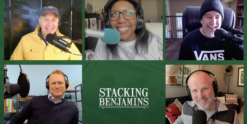You know what phrase I’m tired of hearing?
“Social distancing.”
This term is unhelpful and promotes dangerous isolation from friends, families and acquaintances.
I prefer the phrase “physical distancing.”
Encouraging “physical distancing” promotes interaction, albeit safely and within the guidelines set by our public health officials.
And this is a critical step. Letting go of connections with family and friends is hazardous, even during this lockdown. The “Money Matters” team has long been aware of the importance of social connection in retirement. Isolation can not only affect us mentally but physically, too.
Scientific research has proved that social isolation takes a toll on our bodies. Dozens of studies on the topic demonstrate the adverse health effects of limited social contact and loneliness.
A 2015 study by Brigham Young University (BYU) researchers is the most cited peer-reviewed article on the adverse consequences of social isolation. In this project, the scientists looked at data from 70 prior studies — conducted between 1980 and 2014 — on the issue of isolation’s impact on people’s health.
“Social connections, or the lack thereof, can influence health and the risk of mortality,” say the researchers.
Social isolation was defined in the article as a “pervasive lack of social contact or communication, participation in social activities, or having a confidant.” The BYU researchers described socially isolated individuals as those who have few social network ties, live alone or have infrequent social contact.
Based on their analysis of the previous studies, the BYU researchers found that “(s)ubstantial evidence now indicates that individuals lacking social connections … are at risk for premature (death). The risk associated with social isolation and loneliness is comparable with well-established risk factors for (early death),” including substance abuse, mental illness, poor environmental quality, lack of immunization, obesity, injury and violence, and limited access to health care.
Social isolation is that serious. We knew it wasn’t good for us, but the BYU study put a sharp point on the issue — isolated people are at a 29% higher risk of dying early as their socially active peers.
Isolation also takes a toll on one’s quality of life. The BYU study confirmed that social isolation is associated with adverse health behaviors, including physical inactivity, smoking and poor sleep. The socially isolated also suffer more emotional and psychological problems.
In other words, our lockdown lifestyle puts us more at risk for the health issues associated with social isolation.
For that reason alone, we should try to maintain an active social life while keeping ourselves safe.
Recently, I conducted a study of over 300 happy retirees, semi-retirees and soon-to-be retirees. I wanted to get a feel for how these folks are navigating our current reality. What I found was enlightening and encouraging.
About 60% of respondents said they didn’t get the lockdown blues. Many felt that “America is overscheduled, and the unwind is wonderful.”
The respondents’ top five joy-inducing activities during the lockdown are exercise, limiting news consumption, home improvement and gardening, religion and prayer, and volunteering by making masks. Social gatherings — virtual and socially distanced — were also popular. “Virtual gathering” and “socially distanced gathering” may be the great oxymorons of our time, but they fill an essential role in these unprecedented times by keeping individuals connected.
People also reported being more active in their “core pursuits” — the activities or hobbies they love to do and do often. Some had picked up new core pursuits, but most had delved deeper into existing ones. Some examples include hiking, biking, walking, playing a round of golf (another great way to keep social), cooking, painting and other artistic endeavors, and virtual game night and dinner with friends.
What was also striking in the survey was the prevalence of self-improvement activities. Many of the surveyed retirees and near-retirees reported becoming engaged in learning a new language, a new instrument, how to paint or draw, or taking an online class.
Overall, nearly 70% of those surveyed reported they are staying social in some form or fashion during the lockdown.
The “un-scheduling of America” seems to have prompted the return of some traditional pastimes. Remember when we used to socialize with our neighbors? Well, we’re doing that again. According to respondents, they’re spending more time (safely) with their neighbors. Think physical distancing on patios, porches, backyards, lawns, and heck, even driveways.
Virtual gatherings have been a significant way for people to stay plugged in with one another. Folks are using digital means to connect with distant family and friends, and many reported that they have more family time now.
Other more traditional pastimes that have made a comeback are reading, writing, working jigsaw puzzles, fishing and cooking. People are also talking on the phone more frequently and for longer. They also say they’ve been taking walks with friends to keep in touch.
People have more time to enjoy these activities, and others like them, because we’re living this lockdown lifestyle and not rushing from one place to another.
In my research into the secrets of a happy retirement, I have discovered that the happiest retirees typically have several core pursuits. And they keep busy social lives. In the current situation, these retirees are sticking to these two fundamentals of a happy post-career life.
The unhappy retirees? Well, they tend to have few, if any, core pursuits, and their social interactions tend to be limited. This is exactly why I have long encouraged people to identify their passions and hobbies before retirement. Core pursuits and social interaction are essential for maintaining our mental and physical health in our post-career years.
When asked if they’ll keep their new lifestyle once things return to the pre-pandemic normal, a notable 25% of the group said they plan to adjust their post-lockdown life permanently after the pandemic. To put this into wider context, the 55-plus cohort is about 100 million people in the U.S. So, if a quarter of this population changes their habits going forward, that’s about 25 million Americans whose daily lives and routines will forever be changed by this pandemic.
Even as restrictions loosen here in Georgia and across the globe, we will still face the threat of a virus spike and another lockdown. So, understanding how to use physical distancing while remaining socially connected is an essential skill to hone.
Read original AJC article here
This information is provided to you as a resource for informational purposes only. It is being presented without consideration of the investment objectives, risk tolerance or financial circumstances of any specific investor and might not be suitable for all investors. Past performance is not indicative of future results. Investing involves risk including the possible loss of principal. This information is not intended to, and should not, form a primary basis for any investment decision that you may make. The information contained in this piece is not considered investment advice or recommendation or an endorsement of any particular security. Further, the mention of any specific security is solely provided as an example for informational purposes only and should not be construed as a recommendation to buy or sell. Always consult your own legal, tax or investment advisor before making any investment/tax/estate/financial planning considerations or decisions.













